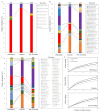Endophytic Fungal Diversity in Cirsium kawakamii from Taiwan
- PMID: 37998881
- PMCID: PMC10671896
- DOI: 10.3390/jof9111076
Endophytic Fungal Diversity in Cirsium kawakamii from Taiwan
Abstract
The endophytic fungal diversity of Cirsium kawakamii, a herb indigenous to Taiwan, was analyzed in this study. In addition, some fungal isolates were evaluated for the risk they pose as plant pathogens. In total, 1836 endophytic fungi were isolated from C. kawakamii from Hehuanjian, Puli Township, and Tatachia. They were classified into 2 phyla, 8 classes, 40 families, and 68 genera. Colletotrichum, Fusarium, Phomopsis, and Xylaria, (Ascomycota, Sordariomycetes) were the dominant genera. The genus accumulation curve (based on the bootstrap estimator) was non-asymptotic, with estimated richness significantly exceeding the richness captured by our sampling to date. Considering the collection time, the data indicated significant differences in the proportions of the C. kawakamii endophyte genus from Hehuanjan, Puli Township (across two seasons), and Tatachia. The Shannon and Gini-Simpson indices revealed variations in diversity, with C. kawakamii endophytes (Puli Township in winter) significantly reducing alpha diversity compared with other seasons and locations. Meanwhile, the Gini-Simpson index suggested that there were no significant differences in richness among the four sampling sites. The PCA results unveiled distinct community structures across different locations and seasons, explaining 46.73% of the total variation in fungal community composition significantly affected diversity and richness. In addition, a considerable number of Fusarium isolates exhibited harmful properties towards wheat, potatoes, and apples. It is postulated that these fungi belong to the Fusarium tricinctum species complex (FTSC).
Keywords: Cirsium kawakamii; Fusarium tricinctum species complex (FTSC); endophytic fungal diversity; pathogen.
Conflict of interest statement
The authors declare no conflict of interest.
Figures





References
-
- Petrini O. Fungal endophytes of tree leaves. In: Andrews J., Hirano S., editors. Microbial Ecology of Leaves. Springer; New York, NY, USA: 1991. pp. 179–197.
-
- Wilson D. Endophyte: The evolution of a term, and clarification of its use and definition. Oikos. 1995;73:274–276. doi: 10.2307/3545919. - DOI
-
- Stone J.K., Bacon C.W., White J.F. An overview of endophytic microbes: Endophytism defined. In: Bacon C.W., White J.F., editors. Microbial Endophytes. Marcel Dekker Inc.; New York, NY, USA: 2000. pp. 3–30.
LinkOut - more resources
Full Text Sources

